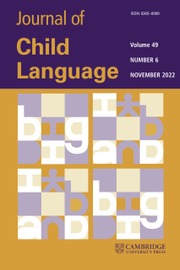Article contents
Parents' use of conventional and unconventional labels in conversations with their preschoolers*
Published online by Cambridge University Press: 05 November 2009
Abstract
Parents' use of conventional versus unconventional labels with their two- (n=12), three- (n=12) and four-year-old children (n=12) was assessed as they talked about objects that were either known or unknown to them. For known objects, parents provided typical conventional labels casually during the conversation. For unknown objects, parents were less likely to use typical nouns as labels and marked their labels with additional information suggesting that the labels might be unconventional. Parents marked potentially unconventional labels by providing explicit statements of ignorance and paralinguistic cues of uncertainty. These patterns were strongest when the unknown objects were manufactured as opposed to homemade, possibly because manufactured objects are supposed to have conventional names that parents were unable to provide. Parents' marking of unconventional labels may help children recognize when new word forms should be treated with caution and guide their learning accordingly.
Information
- Type
- Articles
- Information
- Copyright
- Copyright © Cambridge University Press 2009
Footnotes
We would like to extend our gratitude to the parents and children who volunteered their time to participate in this research. We would also like to thank the research assistants who helped with transcribing and coding of the data: R. DiGiovanni, L. Hong, M. K. Friedman, C. Lang, S. Lue and N. Strang. A special thank you to M. Hurt for her assistance with graphics. We would like to thank the members of the Early Experience Laboratory and the Infant and Child Development Group at Queen's University for their helpful comments on this research. Lastly, we would like to thank N. Akhtar, K. Munhall, S. Fitneva, E. Kelley and A. Woodward for their comments on a previous version of this manuscript. This research was supported by a graduate scholarship awarded to A. M. E. Henderson from the Natural Sciences and Humanities Research Council of Canada and an operating grant awarded to M. A. Sabbagh from the Social Sciences and Humanities Research Council of Canada.
References
REFERENCES
- 8
- Cited by

